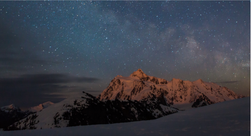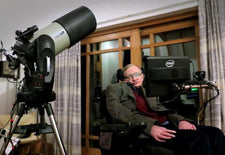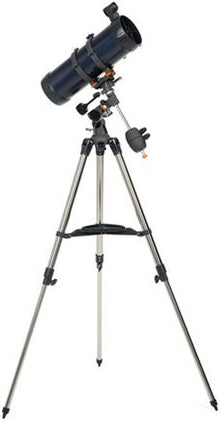Astronomy and Telescopes: Frequently Asked Questions
August 11, 2015
Viewing Celestial Objects
What are the best objects to look at with a basic telescope?
Even a modest telescope or a simple pair of binoculars can reveal impressive objects in the nighttime sky. A small telescope will show you craters on the Moon, the rings around Saturn, and Jupiter with its four brightest moons—Europa, Io, Ganymede and Callisto. You can also watch Venus go through its phases, just like the Moon.
Beyond our Solar System, one of the most popular objects to view is the Orion Nebula. This impressive gaseous region in Orion is actually a nursery where new stars are being born! Other favorite deep sky objects include the Pleiades Open Star Cluster, and the Andromeda Galaxy, our closest galactic neighbor. Take your telescope out to a dark sky site and all these objects will shine much brighter to reveal more detail.
Finally, keep an eye out for reports of comets! These rare celestial visitors come from the outer regions of our Solar System. As they speed toward the Sun, sometimes they brighten enough to become visible with a small telescope or the naked eye.
What can I see on the Moon?
Even amateur astronomers who have been in the hobby for years remain fascinated by the Moon. Our closest celestial neighbor, the Moon offers tons of interesting geographical features to examine. Of course, you can view the Moon’s craters, mountain ranges, and maria—the smooth, darker regions of the Moon that were formed during ancient volcanic activity.
The Moon goes through several phases during its cycle, from full to new and back again. One of the best times to view the Moon is during its partial phases. Scan along the terminator, the line separating night from day on the lunar surface. There, sunlight will cast interesting shadows, causing craters to appear almost 3D.
How can I safely view the Sun?
First of all, we have to tell you what not to do when trying to observe the Sun. Never look directly at the Sun with the naked eye or with a telescope. Never use an eyepiece filter on your telescope to view the Sun. Doing so can cause heat buildup inside the optics, causing the filter to crack and unfiltered sunlight to pass through to the eye. You can also damage your telescope by using it to project an image of the Sun onto a white card or other surface.
Now that we’ve covered the don’ts, you have a few options for safely viewing the Sun. The easiest is to purchase a pair of solar glasses. These inexpensive glasses block out all the harmful light from the Sun, allowing you to view the solar disk and sunspots. You can buy a similar filter for your telescope. Make sure it’s fitted to the exact size of your telescope’s objective.
The best—albeit most expensive—way to view the Sun is with a dedicated solar telescope. Unlike glasses and regular telescopes which display the Sun in white light, solar telescopes show other wavelengths of light, such as Hydrogen-alpha. In this wavelength, you can observe solar flares and prominences shooting off the surface of the Sun, in addition to sunspots and other phenomena.
Why are some nights better than others for viewing with a telescope?
The short answer is seeing conditions. Just as the weather varies from night to night, the stability of the atmosphere also changes. A good way to assess seeing conditions is to step outside and look at the stars. Are they twinkling like crazy or shining bright and stable? Twinkling stars mean there’s a lot of turbulence in the upper atmosphere. When you view the night sky through the turbulence, you’ll magnify that twinkling effect; your images will be fuzzier and less detailed. Nights with clear, stable air are the best for observing and especially for astroimaging.
Telescope Basics
Can I test-drive a telescope before I buy?
Absolutely! We recommend contacting your local astronomy club to find out when they are having their next public star party. Star parties are a great way to meet other amateur astronomers and try out lots of different telescope designs. You might find that your favorite telescope is one you hadn’t even considered before. The amateur astronomers you meet at star parties love introducing newcomers to the hobby. They’ll be happy to provide tips, advice, and plenty of free views through their scopes!
Now that I have a telescope, which accessories do you recommend?
You can take your observing sessions to the next level by adding a few high-quality accessories. For beginners, we recommend low-power eyepieces that provide sharp, wide-field views for observing larger objects like nebulae. We also love the TELRAD Reflex Sight as an upgrade to your traditional finderscope. This simple accessory provides 1x magnification and projects circular rings to help you center the object you wish to view. You may also want to consider Vibration Suppression Pads. These small discs sit under your telescope’s tripod legs to keep everything stable even when people are walking or moving around nearby. Finally, think about dabbling in astrophotography! There are lots of great accessories to get you started, from an adapter so you can snap photos through your smartphone to a dedicated planetary imaging camera, all of which start at under $100.
Do I need to learn how to use a star chart to use a telescope?
Gone are the days when amateur astronomers needed to study star charts to locate celestial objects. Many consumer telescopes, including ones under $300, have built-in GoTo technology, meaning they can find celestial objects for you in the night sky.
But even beginners with a manual telescope can navigate the cosmos without the help of a star chart. There are dozens of free and paid planetarium apps available for your smartphone or tablet. Simply hold your device up to the night sky and you can instantly identify thousands of objects. Some even allow you to simulate sky conditions for a future date, allowing you to plan your night of observing ahead of time.
We should note, however, that old-fashioned star charts and planispheres can be very valuable for new amateur astronomers. Learning to use one takes just a few minutes, and it will prove invaluable as you grow within the hobby.
How can I help my child get a better view through the telescope?
Children, and even newbie adult observers, can have a tough time seeing an image through a telescope’s eyepiece. The key to solving this problem is to ensure that the viewer’s eye is perfectly aligned with the exit pupil of the telscope’s eyepiece. Try centering a bright object, such as the Moon. Have your little observer stand on a step or stool and position their head directly over the eyepiece. (Some children can be grabby, so encourage them to keep their hands in their pockets and not to touch the telescope.) Watch your child’s profile as they look through the eyepiece. You should see a bright spot projected somewhere on their face, near the eye. Instruct them to move their head until the light beam is directly entering their pupil. You’ll know you hit the jackpot when you hear, “Wow!”
Can I see more detail with a higher power eyepiece?
No! High power eyepieces provide more magnification, increasing the overall size of the image in your eyepiece. However, they do not add any more detail to the image. Imagine enlarging a photo on a copy machine. You can increase the image scale, but as the object gets larger, the resolution does not. Be careful not to add too much magnification to your image, so you can keep your views sharp and bright. A good rule of thumb is 50x magnification for every inch of aperture.
Why do astronomers use red flashlights?
While some animals like bats and owls are known for having excellent night vision, humans have a decidedly poor ability to see in the dark. To get a better view through our telescopes, we need our eyes to “dark-adapt,” that is, the pupils need to open to their widest setting to let in the maximum amount of light. It can take 30 minutes to an hour for our eyes to completely open up for prime sky-viewing. Most artificial light, and especially the blue-tinted light emitted from smartphone screens and other devices, causes our pupils to immediately contract, destroying our night vision. The one exception to this is red light. The long wavelengths and low frequency of red light do not disturb our eyesight. (It’s the same reason film developers use red lights inside their darkrooms.)
Whenever you’re out observing, take care to protect your own night vision and that of those around you. Avoid any white light sources until it’s time to clean up for the night!
I live in the middle of a big city. Is it even worth it to buy a telescope?
You may have heard that if you live in a densely populated area, city lights drown out the stars in the night sky. This phenomenon is called “light pollution.” Although light pollution is a very real problem, it won’t interfere with many of the best celestial objects, so don’t let it deter you from getting started in amateur astronomy.
Even if you were to set up your telescope in the middle of Times Square or the Las Vegas strip, you’d still be able to view a surprising number of objects. Because the Moon and planets are relatively close to us, they can compete with bright lights on the ground. You’ll be able to view the Moon, Venus, Jupiter and its moons, Saturn with its rings, and more. Beyond the Solar System, you can catch the Orion Nebula or the Pleiades Star Cluster under light polluted skies.
There are a few things you can do to enhance your viewing if you live in a light polluted area. Try getting to a local park or up on a hill. Look for a place without many streetlights and with good visibility of the horizon. (Make sure to pack along red flashlights for safety.) It’s well worth it to drive just 30 minutes away from the city center for substantially darker skies. If you can take your telescope on a weekend getaway or camping trip, even better.
Astronomy Basics
How far can I see with a telescope?
This is one of the most common questions asked in amateur astronomy, and the answer might surprise you. Believe it or not, you can see a celestial object over 2 million light years away with the naked eye—the Andromeda Galaxy. The real question here is not distance, but brightness. There are many objects closer to us than Andromeda that you need a powerful telescope to observe. But since Andromeda is so bright, we can see it despite its distance. Of more than 100 famous celestial objects cataloged by Charles Messier, the farthest is the Sombrero Galaxy, about 65 million light years away. Under dark skies and excellent seeing conditions, you can view this object in a telescope 8” or larger.
Is it true that telescopes can help us see back in time?
Yes! Light travels at a rate of about 186,000 miles per second. So the next time you look up at the Moon, remember you’re actually viewing light that left the Moon about 1.3 seconds ago. Of course, the light from more distant objects takes even longer to reach us. For example, the Pleiades Star Cluster is 444.2 light years from Earth. That means when the light left the star cluster, Galileo hadn’t even built his first telescope yet! (He was about 7 years old at the time.) In the last question, we talked about the Sombrero Galaxy, visible in larger aperture telescopes. At a distance of 65 million light years away, light was leaving this galaxy headed to Earth while dinosaurs still roamed our planet. Scientists have used powerful research telescopes to view traces of light left over from the Big Bang, which they estimate to be about 13.8 billion years old. Pretty amazing!
Why do the Moon and Venus go through phases?
It takes the Moon about one month to orbit the Earth. As it does, its position in relation to the Earth and the Sun changes. When the Moon is on the opposite side of the Earth as the Sun, the Sun is illuminating the entire face of the Moon, what we call the Full Moon. When it’s on the same side as the Sun, sunlight is illuminating the “dark side” of the Moon that we can’t see, so it appears that there is no Moon in the sky at all. Anytime in between, we see partial phases of the Moon. When viewing Venus through a telescope, you may notice that it goes through the same phase cycle, but on a different schedule as it makes its own orbit around the Sun.
What is light pollution and is there anything I can do to reduce it?
As we mentioned above, light pollution is the result of bright city lights overpowering our natural dark skies. Light pollution is not only a problem for astronomers, it also affects countless species of birds and wildlife that rely on the natural cycles of darkness and light to hunt, camouflage, and migrate.
The good news is, you can help reduce light pollution! New lighting technology has made it possible to keep light where we need it—on the ground and out of the night sky. Encourage your city government to replace streetlights with ones that don’t bounce light into the sky. You can even change the lighting around your home to these dark sky-friendly designs. Visit the International Dark-Sky Association to learn more.



